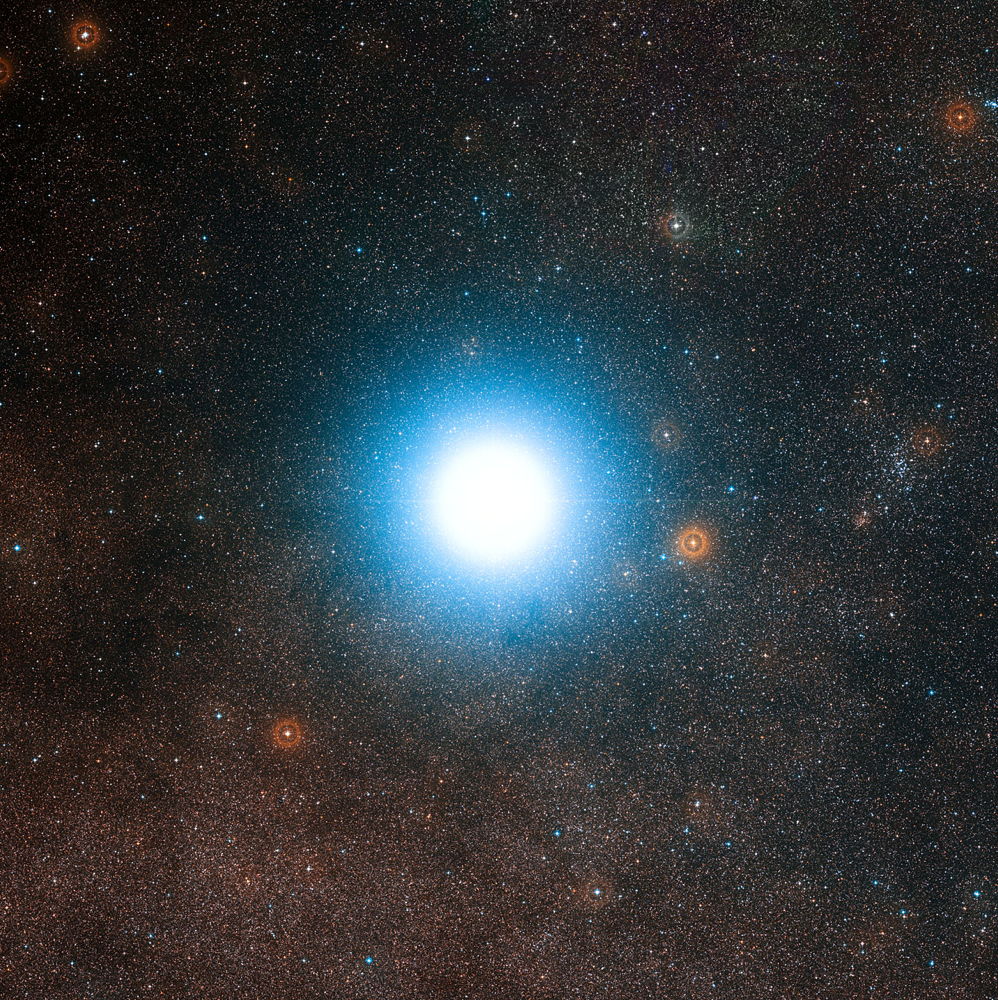Rigel Kentaurus (Alpha Centauri): Third-Brightest Star

Rigel Kentaurus is the third-brightest star in the night sky. However, its brightness is due to the proximity of the system — commonly known as Alpha Centauri — which is the sun's closest neighbor, about 4.3 light-years away from Earth.
Rigel Kentaurus is part of a triple star system, and the naked-eye star itself is a double star. Its two stars are dwarfs that spin around each other every 80 years at an average distance of 23 Earth-sun distances, or astronomical units. This puts the stars at about the same equivalent distance apart as the sun and Uranus in our own solar system, according to University of Illinois astronomer Jim Kaler.
By itself, Alpha Centauri A is the fourth brightest star in the sky; just a bit dimmer, by 0.02 of a magnitude, than Arcturus. It is a yellow star of the same type (G2) as the sun, and it is about 25 percent larger. Alpha Centauri B is an orange K2-type star, slightly smaller than the sun. Proxima Centauri is a red dwarf about seven times smaller than the sun, or one-and-a-half times bigger than Jupiter. [The Brightest Stars in the Sky: A Starry Countdown]
Historical observations
The star was first revealed as a double one in 1689, according to a 1984 paper published in the Bulletin of the Astronomical Society of India.
According to the paper, Jean Richaud, who was part of the Jesuits, used a 12-foot telescope from his post in India to look at Rigel Kentaurus, a star that is impossible to spot at latitudes above 30 degrees north. That's when Richard noted the single was actually a double. The paper said that this was only the second double star ever discovered.
It would take more than 200 years for the fainter Proxima Centauri — a "dim red dwarf", according to astronomer David Darling — to come into view. Robert Innes spotted the star in 1915. Innes was an experienced binary star observer who made 1,628 discoveries at the Cape Observatory, South Africa, according to the European Space Agency. Proxima is the closest of the star system to Earth, at 4.22 light-years away.
Location
The system is in the Southern sky and is not visible to observers above the latitude of 29 degrees north — a line that passes near Houston, Texas, and Orlando, Florida. In the Southern Hemisphere, it's easy to find because the cross-piece of the Southern Cross (from Delta to Beta Crucis) points the way. The system's location is:
- Right ascension: 14 hours 39 minutes 41 seconds
- Declination: -60 degrees 50 minutes 7 seconds
[Infographic: The Nearest Stars to Earth]
Similarities to Earth's sun
Early in 2013, astronomers announced they had found a mysterious cold layer on Alpha Centauri A that looks similar to another one on Earth's sun.
Temperature does not rise sequentially in the sun's layers; the topmost layer (or corona) is millions of degrees Fahrenheit, but just below it is a layer called the chromosphere that is only about 7,300 degrees F (4,000 C) – cooler than the layer below. A similar layer was observed on Alpha Centauri A, which was spotted in far infrared using the European Space Agency's Herschel space observatory.
"The study of these structures has been limited to the sun until now, but we clearly see the signature of a similar temperature inversion layer at Alpha Centauri A," stated study leader René Liseau of the Onsala Space Observatory in Sweden at the time.
Magnetic field line twists could be responsible for the high heat in the sun's corona, but it's hard to fully comprehend the sun in isolation without looking at other stars. At the time, astronomers said looking closely at Alpha Centauri A could bring more information to light about the corona, solar flares and similar phenomena, especially because the stars are pretty close in terms of temperature, age and other properties.
Planet discovery
Astronomers announced in August 2016 that they had detected an Earth-size planet orbiting Proxima Centauri. The newfound world, known as Proxima b, is about 1.3 times more massive than Earth, which suggests that the exoplanet is a rocky world, researchers said.
The planet is also in the star's habitable zone, that just-right range of distances where liquid water can exist. Proxima b lies just 4.7 million miles (7.5 million kilometers) from its host star and completes one orbit every 11.2 Earth-days. As a result, it's likely that the exoplanet is tidally locked, meaning it always shows the same face to its host star, just as the moon shows only one face (the near side) to Earth.

Join our Space Forums to keep talking space on the latest missions, night sky and more! And if you have a news tip, correction or comment, let us know at: community@space.com.
Breaking space news, the latest updates on rocket launches, skywatching events and more!

Elizabeth Howell (she/her), Ph.D., was a staff writer in the spaceflight channel between 2022 and 2024 specializing in Canadian space news. She was contributing writer for Space.com for 10 years from 2012 to 2024. Elizabeth's reporting includes multiple exclusives with the White House, leading world coverage about a lost-and-found space tomato on the International Space Station, witnessing five human spaceflight launches on two continents, flying parabolic, working inside a spacesuit, and participating in a simulated Mars mission. Her latest book, "Why Am I Taller?" (ECW Press, 2022) is co-written with astronaut Dave Williams.
